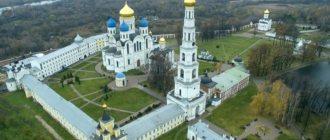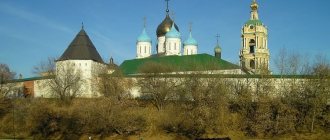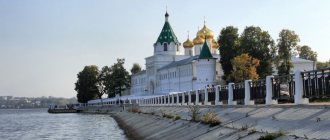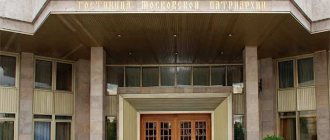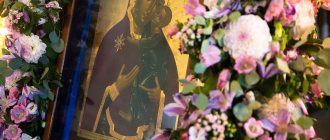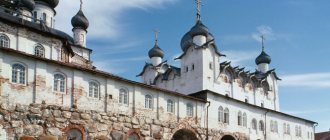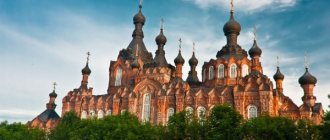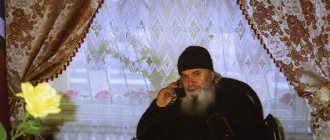The Orthodox Nikolo-Peshnoshsky monastery is one of the oldest in the north of the Moscow region, located approximately 80 kilometers from the Moscow Ring Road, near the village of Rogachevo, Dmitrovsky district.
An ancient willow alley leads from Rogachev to the monastery. According to legend, the willows were planted during the time of Catherine II, and the alley itself was called Catherine's.
The monastery was founded in 1361 by the monk Methodius of Peshnoshsky, a student of Sergius of Radonezh.
Methodius erected the first buildings “pesh nosha” - carrying logs on foot along a ford across the river, so he himself, the monastery, and the river Peshnosha, flowing near the monastery walls, received this name.
The first buildings were wooden and have not survived to this day. During the heyday of the monastery in the 16th century, thanks to good profits from the grain trade with Belozersk, as well as generous donations from the Dmitrov princes and Tsar Ivan the Terrible, they were gradually replaced with stone ones.
Despite the difficult history of the monastery, the unique architectural ensemble has been preserved with virtually no losses; today the monastery buildings have been completely restored.
Entrance to the territory is through the passage gate of the Spasskaya observation tower.
In May 1553, Ivan the Terrible came to the Nikolo-Peshnoshsky Monastery on a pilgrimage. The meeting with Elder Vassian, who was living there in retirement, had a great influence on him.
The king asked Vassian: “Father, what is the best way to rule the state?”
“If you want to be a true autocrat, then do not have advisers wiser than yourself. Follow the rule that you must teach, and not study, command, and not obey. Then you will be strong in the kingdom and a threat to the nobles,” answered the elder.
Ivan the Terrible said to this: “My father himself could not have given me better advice.”
View of the Spasskaya Tower from the inside:
The central part of the architectural ensemble.
On the right is the ancient Cathedral of St. Nicholas the Wonderworker, built at the end of the 15th - early 16th centuries, in the middle is the Church of St. Sergius of Radonezh, built over the tomb of Methodius of Peshnosh, on the left is the bell tower with the Church of the Epiphany.
Over its long history, the monastery has experienced a lot: during the Time of Troubles it was robbed by the Poles, many monks then fell from the sword of enemies, and monastery buildings burned.
In 1700, during his voyage along the Yakhroma River, Peter the Great visited the Nikolo-Peshnoshsky Monastery, and, after a complaint from Abbot Feofan about the disobedience of the peasants and injustice on the part of the civil authorities, by his decree in order to “with strong power tame the disobedient and protect the monastery from injustice,” assigned to the monastery of the Trinity-Sergius Lavra.
However, Peter's decree played a bad role: the monastery, deprived of independence, fell into decay and ruin.
Hospital Church of Dmitry of Rostov, connected to hospital wards.
A new heyday came at the turn of the 18th and 19th centuries. - under Hieromonk Macarius, Peshnosha became one of the most beautiful and comfortable monasteries, it was even called the “second Lavra”. In those days, the monastery was a large landowner, owning more than two thousand “souls” of peasants.
The Holy Gate with the elegant gatehouse Church of the Transfiguration.
In the first years of Soviet power, the Dmitrov Museum of Local Lore was located in the monastery buildings. In 1927, there was a Home for the Invalids of the Moscow Regional Social Security Service, and in 1966, there was a Psychoneurological boarding school No. 3 of the Department of Social Protection of the Population of Moscow.
The last Peshnosha monks were shot at the Butovo training ground in the 1930s.
In 2008, Karen Shakhnazarov filmed the film “Ward No. 6” here based on the story by A.P. Chekhov. Patients of the boarding school took part in the filming.
Chapel of John the Baptist over the Holy Spring.
Northern fraternal building and corner tower.
In the background is the two-story Church of the Presentation of the Lord with facades in the classicist style.
Sundial on the wall of the Sretensky Church.
Since 2007, gradual restoration has begun: churches and fraternal cells are being restored, and services are held. In 2013, the Psychoneurological Boarding School moved to a new building outside the monastery walls, and on August 24, 2014, the grand opening of the entire territory of the monastery after restoration took place, timed to coincide with the celebration of the 700th anniversary of Sergius of Radonezh.
In this photo on the right you can see the white stage and stands erected especially for the outdoor Liturgy by Patriarch Kirill in honor of this event.
Corner southwestern tower, part of the refectory and abbot's building.
The area is very well maintained.
There is a small gate in the eastern wall.
Outside, to the left, diagonally, there is a path to the monastery zoo.
Camels live here.
Evil pterodactyls (actually I forgot what these birds are called).
Peacocks, deer, goats, black foxes, pheasants, squirrels, rabbits, African ostrich and other inhabitants.
A little further from the zoo there is a holy spring and a font. We accidentally learned about their existence - a large group of pilgrims came to this place with us.
Let's go back. The height of the fortress wall is more than 10 meters, thickness is 2.5 meters, there are combat embrasures in the wall and towers.
The monastery has its own farm; in the shop you can buy eggs, dairy and meat products from the monastery farmstead.
Historical events
The Nikolo-Peshnoshsky Monastery (Dmitrovsky district) was founded by a monk, a student and follower of Sergius of Radonezh in the 14th century. The monk Methodius, in search of a place for a solitary pilgrimage, settled in a small cell built by the river, about a kilometer from the modern location of the monastery.
The hermit became famous throughout the area for his holy life, people flocked to him for help and consolation, and gradually those thirsting for monastic life began to stay and live with Methodius. There was a need to build a church. Sergius himself indicated the place for it, thereby choosing the location of the future monastery near a tributary of the Peshnoshka River.
The first wooden church was consecrated in honor of St. Nicholas in 1361, which was the reason for the name of the monastery.
There is another version of the name of the monastery, which suggests that it came from a combination of the words walking burden, since the Monk Methodius carried logs on foot across the river during the construction of the church. The fame of the monastery continued to grow, attracting numerous pilgrims, donors and benefactors, which led to the prosperity and wealth of the monastery.
Among the main benefactors, one can especially highlight the sons and descendants of the most famous princely families and royal persons. From the middle of the 15th century, the monastery actively traded in surplus stocks of grown bread, which made it possible to build the first stone cathedral.
At the end of the 16th century, a severe fire destroyed almost all the monastery buildings. And in troubled times at the beginning of the 17th century, the newly built monastery was burned and taken by the Poles, despite the selfless resistance of the monks. During the defense of the monastery from the enemy sword, 2 hieromonks, 2 priests, 1 hierodeacon, 6 schema-monks and 37 laborers were killed.
Under Tsar Mikhail Romanov, the monastery was revived again. By the middle of the century there were already 3 stone churches with a bell tower, refectories with cellar chambers, and other outbuildings made of stone and wood. Repeatedly throughout the history of the monastery, it was visited by royalty, who provided rich contributions for the construction of churches.
In the middle of the 18th century, a church was erected over the grave of the reverend founder of the monastery, Methodius, in honor of his teacher Sergius of Radonezh, the walls with towers were strengthened, and a new road was paved. From this time on, the former heyday of the monastery ended and a period of desolation began, which led to the closure of the monastery in 64 due to ongoing secularization reforms in the country.
But after 1.5 years, the monastery was opened at the request of Mikhail Verevkin, a local landowner, who was joined by merchants from Dmitrov Ivan Sychev and Ivan Tolchenov. The renewed monastery began to submit to the Pereyaslav diocese, and by the end of the century before last it transferred to the Moscow Metropolis.
During this period, its new blossoming begins, the monastery is rebuilt and expanded, taking on its final appearance.
In 1928, the monastery was closed, all buildings were transferred to the Dmitrov Museum of Local History, which made it possible to preserve the main church values, but not for long, since the directors were soon repressed and the museum was closed. For a long time after this, the entire territory was occupied by a Home for the Invalids, and then it was transferred to a psychoneurological boarding school, where it existed until 2013.
The Jubilee Orthodox Council of the church glorified in 2000 4 new martyrs who emerged from the walls of the monastery:
- Gerasim Mochalov;
- Josafa Shakhov;
- Nikolai Saltykov;
- Aristarkha Zaglodin-Kokorev.
Opening of the “second monastery”
At a meeting of the Holy Synod of the Russian Orthodox Church on August 21, 2007, it was decided: “To bless the transformation of the parish of the St. Sergius Church of the village of Lugovoy, Dmitrovsky district, Moscow region into the Nikolo-Peshnoshsky Monastery... To appoint Hieromonk Nikon (Golovko) as the rector of the Nikolo-Peshnoshsky Monastery with ordination abbot."
Nikolo-Peshnoshsky Monastery. Photo: Vitaly / Sobory.Ru
In pursuance of this decision, on September 2, 2007, after 80 years of devastation, the Nikolo-Peshnoshsky Monastery, founded in the 14th century by the disciple and co-faster of the great Sergius of Radonezh - St. Methodius, is reopened.
The service on this historical day will be performed by Metropolitan Yuvenaly of Krutitsa and Kolomna, co-served by Bishop Roman of Serpukhov and the abbots of the monasteries of the Moscow diocese. The Divine Liturgy will begin at 10:00 in the St. Sergius Church of the monastery.
Monastery address: Moscow region, Dmitrovsky district, village. Lugovoy. More detailed information about the monastery can be found on the official website of the monastery www.peshnosha.ru.
Brief history of the Nikolo-Peshnoshsky Monastery
Venerable Methodius of Peshnoshsky
Nikolaevsky Peshnoshsky Monastery is one of the oldest monasteries in Moscow Rus'. Currently, the monastery is entering the seventh century of its existence.
The monastery was founded in the 14th century by the disciple of Sergius of Radonezh - the Monk Methodius of Peshnosh. Saint Methodius, one of the first disciples of the great Abba, chose a place for desert living 25 versts from Dmitrov on the Yakhroma River, where he built himself a cell. The Monk Methodius himself worked on building the monastery, “carrying” logs across the river on foot. Hence the monastery received the name Peshnoshskaya.
The Monk Sergius often visited his disciple in his solitude. It is known that Saints Methodius and Sergius together dug ditches for cells, dug two ponds and planted an alley of elms, which has survived to this day. Upon the establishment of the monastery, with the blessing of Saint Sergius, the Monk Methodius became its first abbot.
The Monk Methodius died on June 14, 1392. It is remarkable that, having followed the example and instructions of St. Sergius during his life, he did not hesitate to follow him to the eternal monasteries: St. Sergius preceded him only eight months. The miraculous relics of St. Methodius still rest hidden in the monastery he built.
The glory of the holy life of St. Methodius, even after his death, attracted pilgrims and rich donors - boyars and grand dukes - to the monastery he founded. Among them are the appanage princes of Dmitrov Peter Dmitrievich, the son of the blessed Prince Dimitry Donskoy, and Yuri Vasilyevich, the son of the Grand Duke of Moscow and All Rus' Vasily II Vasilyevich the Dark. It is also known about the generous donations to the monastery of Tsar Ivan Vasilyevich the Terrible, who especially favored the builder of the monastery, Hieromonk Gury (Zabolotsky). Thus, Ivan the Terrible determined an annual monetary salary for the Peshnoshsky Monastery. This royal favor can be attributed both to the personal dignity of the builder Guria, who attracted the attention of the sovereign, and to the splendor of the monastery. Soon, Gury became the archimandrite of the Simonov Monastery, in 1543 he was consecrated bishop of Smolensk and Bryansk, and in 1551 he was a participant in the Council of the Hundred Heads.
Saint Barsanuphius of Kazan
During the abbotship of Gury's successor, Abbot Barsanuphius, the future saint and wonderworker of Kazan, in the Nikolo-Peshnoshsky monastery, in 1553, Tsar Ivan the Terrible, together with his wife and one-year-old son, made a pilgrimage to the Trinity-Sergius, Peshnoshsky and Kirillov monasteries.
All the monastery buildings burned down due to a fire in 1584. And as soon as the monastery rose again from the ashes, disastrous turmoil for Russia began from the impostors. The Peshnoshsky monastery was devastated by the Poles: it was again burned, plundered, and many of its monks, who bravely defended the monastery from enemies, were beaten. After the turmoil, the monastery was restored again, but the land, hitherto watered by the tears of the ascetics, was stained with their blood: two hieromonks, two priests, one hierodeacon, six schemamonks and seven monks fell from the sword of godless enemies. History has preserved their names for posterity in the depths of the earth: during the reconstruction of St. Nicholas Cathedral in 1805–1806, stones were found with the names of the victims carved on them.
The year 1700 became a turning point in the history of the monastery: that summer, Tsar Peter I sailed along the Yakhroma and Dubna rivers to the Volga and visited Peshnosha. During his stay at the monastery, the king heard a complaint from Abbot Theophan and his brethren about the disobedience of the peasants and injustice on the part of the civil authorities in court cases. In order to “tame the rebellious with strong power and protect the monastery from injustice,” he, by his personal decree, ordered the Peshnosha Monastery to be under the jurisdiction of the Trinity-Sergius Lavra.
In its new position, the Peshnosha monastery, instead of abbots, began to be governed by cathedral elders sent from the Lavra - for three years each. However, the tsar’s decision became fatal: the monastery, deprived of independence, began to quickly fade away and was even abolished in 1764.
In 1766, at the request of a nearby landowner, actual state councilor M.I. Verevkin, the monastery was restored again, but then, according to the last administrative division, it became part of the Pereslavl diocese. From here began the period of true prosperity of the Nikolo-Peshnoshsky monastery, which continued until the troubled days of the 20th century.
The first builder appointed from the diocese to the revived monastery was Hieromonk Ignatius, who later renovated the Moscow Simonov Monastery. Through his diligence, the rules of the hostel were established in the Peshnosha monastery, proper order, improvement and exemplary severity were established in everything in the life of the monks, and in the church service, distinguished by its length and splendid singing, the rite of Mount Athos was introduced. All this together glorified the Peshnosh monastery on a par with the Valaam Monastery and the Sarov Hermitage.
In 1788, on the occasion of the abolition of the Pereslavl diocese, the Peshnoshsky monastery came under the jurisdiction of the Moscow diocese. At that time, the builder of the Peshnoshsky monastery was already hieromonk Macarius, whose relics still rest in secret in the abbot’s church-tomb under the bell tower. Many very significant transformations in the monastery are associated with his name - it was in those years that the monastery acquired the appearance that has remained to this day.
Metropolitan Platon (Levshin)
Having arranged everything in the best possible way, the zealous builder convinced His Eminence Metropolitan Platon (Levshin) to visit the monastery, and the archpastor, having stayed in the monastery for several days, was amazed at the excellent order, order, housekeeping, cleanliness, fraternal meals and everything else. Without leaving a single corner without inspection, he even climbed the high bell tower, from where he surveyed the surroundings of the monastery. “Peshnosha in my diocese is the second monastery,” Bishop Plato later liked to repeat.
And in fact, the Peshnoshsky monastery in the days of Father Macarius was so famous that in other desert monasteries they talked about it with spiritual delight. Metropolitan Platon often set Hieromonk Macarius and his monastery as an example to other abbots. Many borrowed order and even monastics from Peshnosha. So the abbot of the Kirillo-Novoezersk monastery, being on Peshnosh, borrowed her ecclesiastical order and asked Macarius for help in establishing a hostel for several monks. Father Macarius had a spiritual connection and correspondence with the archimandrite of the Moldavian-Vlakhian Nyametsky monastery, elder Paisius, and even received a staff from him as a gift.
In 1795, Metropolitan Plato ordered the builder Macarius, if he finds it necessary, to change the builder of the Optina Hermitage, that is, to put another in his place, at the same time he was ordered to visit this hermitage and establish everything for the better. In 1798, at the request of the brethren of the Davidic Hermitage, it was ordered to “start everything that is on Peshnosh” in it. This metropolitan definition says: “to order the Peshnosha builder to establish the same society in the Davidov Hermitage as in the Optina Monastery.”
Meanwhile, the power of attorney for the location of the Moscow Archpastor to the builder remained unchanged. In 1800, they were given the following instructions: “To the father of the builder of Peshnosh, Macarius. You should go to Kolomna to inspect the abolished Golutvin monastery and the provincial Bobrenev monastery. Moreover, you are given information about the Bobrenev monastery, utensils, buildings and lands. And upon your return, tell us. Plato, Metropolitan of Moscow."
The charter and order of the monastic community from the Peshnoshsky monastery were borrowed by the Moscow Sretensky and Intercession monasteries, the Serpukhov Vladychny monastery, the Kolomna Golutvin monastery, the Dmitrov Borisoglebsky monastery, Bobrenev monastery, as well as the deserts of Optina, Ekaterininskaya and Davidova and others. Many of these monasteries were governed by abbots appointed from among the Peshnosh brethren.
Like the Monk Macarius, another rector of the monastery, Hieromonk Maxim, known in history for his wise rule and efforts to beautify the monastery, testified with his holy life the feat of venerability.
Thus, the 19th century passed in constant development and improvement of the already remarkable monastery.
By the beginning of the 20th century, the number of brethren of the monastery was approaching 200, not counting novices and laborers.
The Peshnoshsky Monastery was closed in 1928, giving the Russian Orthodox Church four new martyrs. At the Jubilee Council of Bishops in 2000, the venerable martyrs Gerasim (Mochalov; † 1936), Joasaph (Shakhov; † 1938), Nicholas (Saltykov; † 1937) and Aristarchus (Zaglodin-Kokorev; † 1937) were canonized in the Council of New Martyrs and Confessors of Russia. .
An attempt by the director of the Dmitrov Region Museum K.A. Solovyov and his staff to turn the monastery into a museum, undertaken in 1928–1931, was not crowned with success. In January 1933, the entire museum was destroyed, and its employees, led by the director, were repressed.
Over the past few decades, the territory of the monastery has been occupied by psychoneurological boarding school No. 3, subordinate to the Moscow Regional Social Security Administration.
Appearance of the monastery
Nikolo-Peshnoshsky Monastery. Photo: peshnosha.ru
The monastery forms an irregular quadrangle with a length of sides from 170 to 220 m, it is entirely surrounded by a stone wall with a covered passage in it, in some places built up with monastery buildings. The height of the wall is more than 10 m, the thickness reaches 2.5 m. The wall is decorated with a number of battlements, machicolations and battle embrasures. The walls are connected by four corner and two side towers up to 17 m high, with two gates - the holy ones, on the western side to the Yakhroma River, and the entrance ones, on the northern side. Above the latter there is a magnificent observation tower, the Spasskaya Tower, more than 35 m high. From below and up to half the height it is quadrangular, gradually narrowing, it forms a beautiful octagonal tent.
The main temple of the monastery - the oldest white-stone St. Nicholas Cathedral of the first third of the 15th century - has survived to this day. Under a layer of whitewash on the walls of the cathedral, frescoes by Andrei Rublev are still preserved.
The unique architectural ensemble of the monastery is complemented by a perfectly preserved bell tower, the two lower tiers of which with arcades and the Epiphany Church “under the bells” were rebuilt at the beginning of the 16th century, and the two upper tiers of the bell were added in 1793. The church under the bell tower, which is the abbot's burial vault, was consecrated in honor of the Monk Methodius.
Next to the bell tower there is a church in the name of Sergius of Radonezh, erected over the relics of St. Methodius. This temple and the monastery bell tower currently belong to believers and are being actively restored.
In addition to these monuments, the refectory Church of the Presentation of the Lord, built in the first half of the 16th century, is preserved in the monastery. In the basement of the church there is a unique single-pillar chamber, created according to the type of similar chambers of the Andronikov Monastery and the Faceted Chamber of the Moscow Kremlin.
In the southwestern corner of the monastery, next to the hospital wards for the elderly brethren, there is a hospital church in the name of St. Demetrius of Rostov. Above the holy “Yakhroma” gates, located in the western part of the wall, the Church of the Transfiguration of the Savior of the late 17th century has been preserved.
Among the civil buildings in the monastery, the buildings of the late 17th - early 18th centuries have been preserved - the abbot's, treasury and several fraternal buildings.
In general, the entire architectural ensemble of the Nikolo-Peshnoshsky Monastery has been preserved without loss, but requires restoration.
Burials inside the Nikolo-Peshnoshsky Monastery
The Nikolo-Peshnoshsky Monastery is also known for its unique noble necropolis.
Inside the St. Nicholas Cathedral and in the monastery cemetery lie the ashes of representatives of almost all famous Russian noble families and families, including the Obolenskys, Volkonskys, Dolgorukovs, Vyazemskys, Apraksins, Orlovs, Ushakovs, Turgenevs, Maykovs, Tukhachevskys, Velyaminovs, Yushkovs, Kvashnins, Toporkovs and many, many others.
Here, in the monastery, the relics of the Venerable Methodius of Peshnosh, Archimandrite Macarius, Hieromonk Maxim and the blessed monk Jonah rest under cover.
In the St. Nicholas Cathedral rest the ashes of the 16th century bishops: Kolomna Vassian (Toporkov) and Tver Gury (Zabolotsky), as well as the brethren who were beaten during the Poles’ attack on the monastery in 1613.
Shrines of the Peshnosha Monastery
Nikolo-Peshnoshsky Monastery. Photo: Vitaly / Sobory.Ru
First of all, the shrines of the Nikolo-Peshnoshsky monastery, mentioned in pre-revolutionary inventories, should include the staff and holy relics of St. Methodius of Peshnoshsky, resting under a silver and gilded shrine, as well as the miraculous image of the Mother of God “Before Christmas and after the Nativity of the Virgin”, which saved Emperor Alexander III from sudden death in the accident of the royal train.
In addition to the icon of the Most Holy Theotokos, two images of St. Methodius were venerated in the Nikolo-Peshnoshsky Monastery, a part of the Precious and Life-Giving Cross of the Lord and a piece of the Robe of the Lord, “which is a tunic.”
The monastery preserved such monuments as the wooden chalice on which the Monk Methodius celebrated the Divine Liturgy (now in the collection of the Dmitrov Kremlin Historical and Art Museum-Reserve), as well as a wooden altar cross of ebony, overlaid with red gold, made in the 15th century.
Most of the archives of the Peshnosha Monastery of the 15th–17th centuries are now stored in the Russian State Archive of Ancient Acts.
Perhaps the most famous shrine of the Peshnosha Monastery is the miraculous image of John the Baptist, attributed to the brush of St. Andrei Rublev. Currently it is on display in the main exhibition of the Central Museum of Ancient Russian Art and Culture. Andrey Rublev.
Among the antiquities of the monastery are a double-leaf carved panagia made of mammoth bone in a gilded silver frame and the Four Gospels with a gilded frame and enamel inserts. These wonderful monuments are now in the Sergiev Posad Historical and Art Museum-Reserve.
The State Historical Museum houses a number of manuscripts from the library of the Nikolo-Peshnoshsky Monastery. These are, first of all, the altar Gospel of the Four Gospels, front with ornament, written in semi-character in the 15th century, the life of St. Gregory of Omirite from 1452, and the “Ladder” of St. John Climacus at the end of the 15th century.
An interesting monument that has survived to this day is associated with the name of the appanage prince Yuri Vasilyevich, who made significant contributions to the Peshnoshsky monastery. This is a gilded silver censer from 1469, as is known from the inscription preserved on it. Currently, the censer from the Peshnoshsky Monastery is kept in the Armory Chamber of the Moscow Kremlin.
It is also worth mentioning that in one of the parish churches of the Tver diocese, located not far from the monastery, the staff of the last rector of the monastery - Abbot Yuvenaly - is preserved before the closure, and in the storerooms of the historical and art museum-reserve "Dmitrov Kremlin" - a silver and gilded shrine that stood above the relics of St. Methodius.
The current position of the Nikolo-Peshnoshsky monastery
Nikolo-Peshnoshsky Monastery. Photo: peshnosha.ru
Currently, on the territory of the Nikolo-Peshnoshsky Monastery, the following churches have been returned: the Sergius Church over the relics of St. Methodius of Peshnoshsky and the monastery bell tower with the Epiphany Church and the Methodius Temple-tomb, as well as most of the noble necropolis. With the help of the head of the administration of the Dmitrovsky district V.V. Gavrilov, restoration of the returned buildings is being intensively carried out.
The Epiphany Church, “like the bells,” located on the second tier of the bell tower, is equipped for regular services.
The current situation of the monastery is aggravated by the presence within its walls of a psychoneurological boarding school, the question of removing it from this unique monument was first raised in 1975. The late Chairman of the Board of the Soviet Cultural Foundation, Academician D.S. Likhachev repeatedly proposed creating a national park in the Moscow region, the center of which would be the Nikolo-Peshnoshsky Monastery. But at present, the construction of a new complex to relocate the dispensary has not yet begun.
Architecture, appearance
The architectural ensemble of the modern monastery is a complex of buildings built in the period from the 16th to the first half of the 19th century. The oldest building of the monastery is the St. Nicholas Church, erected in the first half of the 15th century in the early Moscow style as a 2-domed cathedral. The structure was built according to the cross-dome type, with box vaults on 4 powerful internal pillars.
At the end of the 17th century, the church building underwent reconstruction, as a result of which a porch was added on 3 sides. New 4 small domes with tiled coverings appeared, which were removed a century later during the next reconstruction. Today the temple is a single-domed white stone structure, recreated for the 4th time in 2011.
Nikolo-Peshnoshsky Monastery from a bird's eye view.
In the 2nd tier of the stone 8-sided ancient bell tower of the 16th century, the Church of the Epiphany appeared. In 2007, through the efforts and funds of volunteers, a new iconostasis was made there. On the lower floor there is a temple in honor of the founder of the monastery with the limit of John the Baptist. Through the efforts of the merchant Tolchenov, a 2-day clock was installed on the belfry, which regularly strikes the time.
The Sergius-Radonezh Church was erected with patterned red bricks over the resting place of his student and founder of the monastery in 1732 according to the design of the architect M.G. Piotrovich. In conjunction with it, the rector's, treasury and fraternal buildings were built in a pseudo-Russian style.
The Sretenskaya Church of the 16th century was erected over the walls of the old refectory, which preserved traces of a terrible fire of the 17th century. The basement of the temple is a single-pillar chamber, similar to the Andronikov monastery and the Faceted Chamber of the capital Kremlin.
The 6-pillar church building itself is crowned with a decorative classical dome, the entrance part is decorated with columns and a portico with a rare Tuscan order. The façade of the building is decorated with a sundial. The gateway Church of the Transfiguration of the 17th century has a warm vestibule, built in line with the fortress wall, facing the west.
A little earlier, in 1623, a single-domed quaternary temple appeared above the Holy Gates. The Hospital Cathedral of Demetrius of Rostov was erected in the first half of the 19th century.
By the beginning of the 19th century, the monastery was completely surrounded on all sides by a powerful stone wall, which began to be built in the 17th century in accordance with all the rules of defensive structures of that time. The oldest is the section of the western and northern parts with battlements. Battle passages and embrasures were built here. The height of the fortress walls in some places exceeds the 10-meter mark, and the thickness is 2.5 m.
The North-Western and Western watchtowers were built according to the science of fortification as an impenetrable fortress capable of withstanding the most serious assault. At the end of the 17th century, the Spasskaya Tower was built, which played the role of an entrance gate through the powerful walls of the fence, and later became the Holy Gate of the monastery.
Its facade is decorated with elegant window frames, the roof is topped with an 8-sided tent with an equipped observation deck at a height of 35 m. The remaining towers were built in the first half of the 18th century, no longer providing a serious defensive function, but more of an aesthetic value.
Temples
The territory of the monastery accommodates 6 churches:
- St. Nicholas Cathedral;
- Church of Sergius of Radonezh;
- Sretenskaya Church;
- Church of the Epiphany in the bell tower;
- Church of St. Dmitry of Rostov in the hospital building;
- Church of the Transfiguration of the Lord - a temple located above the holy gates near the Yakhroma River.
The oldest of the temple ensemble is the St. Nicholas Cathedral; throughout its history it was restored 4 times and the last time in 2011. In the very center of the monastery is the Sergius Church - this is the name of the temple consecrated in honor of Sergius of Radonezh.
Interior decoration
In the St. Nicholas Church of the monastery, under layers of whitewash, unique ancient frescoes were discovered, belonging to the hand of the unsurpassed Andrei Rublev and his students.
Inside the Sergius Cathedral, near the southern wall, you can venerate the relics of St. Methodius, which rest in a skillfully crafted gilded and silver shrine. The temple room without internal pillars looks very spacious and bright. The walls are decorated with many images and ancient icons.
The interior of the Sretensky Church with 6 massive pillars supporting hipped painted vaults. On the walls at the entrance, frescoes of the Savior and the Virgin Mary were found in good condition, which were successfully recreated by restorers in their original form. An ancient cast-iron staircase leads to the temple.
In the bell tower of the Epiphany Church, the wall painting depicts the Peshnosha venerable martyrs. The finely carved iconostasis is decorated with gold.
Of particular value is the noble necropolis of the monastery, where the remains of the most famous noble families and ancient Russian families rest: the Dolgorukovs, Volkonskys, Vyazemskys, Orlovs, Turgenevs, Obolenskys, Tukhachevskys and many others.
In 1700, Peter the Great visited the Peshnoshsky monastery in the Dmitrov region
Voivode Nikifor Verevkin, who later took monastic vows here, had some influence on the formation of the monastery. In 1683, repair work began on the St. Nicholas Church.
The temple was rebuilt into a five-domed one and covered with tiles. The walls were reinforced with iron brackets. The iconostasis was updated.
Peter was the first to visit the Nikolo-Peshnosh monastery. Photo: img11.postila.ru
At the end of the 17th century, a new Transfiguration Church appeared above the Holy Gates. Tsar Peter wanted to travel by water from the Volga to Moscow, so he sailed along the Yakhroma River. On the way, he stopped at a monastery.
Taking this opportunity, Abbot Feofan filed a complaint with the sovereign about the disobedience of the peasants and that the secular authorities were completely unfair. This had unexpected consequences.
Tsar Peter decided, in order to protect the Peshnosha monastery from injustice, it was necessary to give it under the authority of a stronger monastery.
The monastery was given over to the Trinity Hermitage.
The monastery was not ruled by its own abbots, but by the so-called “builders” sent here every three years from the Lavra.
A lot of useful things were done under the builder August Starkov in 1730 - 34. Over the tomb of Methodius, the venerable abbot, they built a temple in honor of Sergius of Radonezh, erected three towers, and paved a new road.
But by 1750 the monastery began to fall into disrepair. The buildings fell into disrepair, and the number of brethren decreased. For example, in 1761 there were only 6 monks in the monastery.
Zoo
It is very unusual to see a real menagerie with strange animals in an Orthodox monastery. The zoo is located at the eastern wall of the monastery. You can get into it through a small gate. It houses camel and red deer, ostriches, peacocks, pheasants and turkeys. There is also a donkey, several rams and sheep, a wild boar, a squirrel, silver foxes, a raccoon, a porcupine and even a wolf.
White swans swim on the pond, and behind the fence cows graze and horses walk. There is a paddock with ponies, cages with hares and rabbits. The zoo exists on voluntary donations from parishioners and is open all year round, seven days a week. It usually closes at 5 pm, with the start of church services.
Shrines
In addition to many Orthodox icons with pieces of holy relics, the monastery has preserved unique Shrines and ancient cultural and historical objects.
Scroll:
- Silver shrine with gilded trim, where the Holy relics of the saint of God Methodius rest,
- personal staff of the founder of the monastery;
- List of the miraculous image of the Theotokos “Before Christmas and after Christmas,” which saved Emperor Alexander III and his family from certain death during a train crash;
- a piece from the Life-giving Cross of the Lord;
- part of the Lord's robe;
- wooden chalice of St. Methodius;
- altar church cross made of precious ebony with red gold inserts from the 15th century;
- a unique 2-leaf panagia carved from mammoth bone in a gilded and silver frame;
- Gospel in a gilded frame with finely painted enamel inserts;
- A silver censer with gilding, made in the second half of the 15th century, can be seen today in the Kremlin Armory.
Peshnosha Monastery was built in 1361 by St. Methodius
The hermit Methodius searched for a secluded home for a very long time, which is why he built a cell behind the Yakhroma River. Over time, his holiness gained greater fame and people who also wanted monastic feat began to come to him.
When the brethren decided to build a church, the Monk Sergius showed his disciple the place where the temples should be erected.
The monastery was built by the Monk Methodius of Peshnosha. Photo: dmkray.ru
The first church was wooden, built and consecrated in the name of Nicholas of Myra. Methodius crossed the river on foot, carrying logs on his shoulders for the construction of the temple, which is why the monastery was called Peshnoshskaya.
The fame of the monastery quickly spread throughout the area. Pilgrims and benefactors began to arrive.
Interesting facts and legends
Many remarkable events are associated with the history of the unique monastery:
- The monastery was visited by the famous poet Alexander Blok, who dedicated his poem to it.
- Before the miraculous image of the Forerunner of the Lord John the Baptist, painted by Andrei Rublev, in 1569 there was a significant healing of Roman Polyaninov, who was the favorite cup maker of Prince Kurbsky. Today the image can be seen in the Museum of Ancient Russian Art.
- According to the ancient legend about the ancient Miraculous Cross of the 13th century, a copy of which is kept today in the monastery, a blind girl had her epiphany. She, sitting on the bank, accidentally touched a cross floating upstream of the river, and her instant healing occurred. This copy was made in the 19th century. The original of the cross is in the Tretyakov Gallery.
- The preserved ancient elm alley and 2 ponds next to the cells, according to the surviving legend, were planted and dug by the hands of the Monks Sergius and Methodius themselves.
- Recently, the monastery rediscovered the Holy Spring, which was filled up during the Soviet hard times. Today it is ennobled and highlighted by the installed Baptist Chapel-canopy.
- In 2008, Karen Shakhnazarov filmed the film “Ward No. 6” here.
Used materials
- Monastery page on the Moscow Diocese website:
- History of the monastery on the official website:
[1] “Journal No. 52”, Journals of the meeting of the Holy Synod of the Russian Orthodox Church dated August 21, 2007
, official website of the Moscow Patriarchate, August 21, 2007,
[2] “Journal No. 70”, Journals of the meeting of the Holy Synod of the Russian Orthodox Church dated October 6, 2008
, official website of the Moscow Patriarchate, October 6, 2008,
[3] “JOURNAL No. 119”, JOURNALS of the meeting of the Holy Synod of August 30, 2022
, official website of the Russian Orthodox Church, August 30, 2019,
Opening hours and schedule of services
The Nikolo-Peshnoshsky Monastery (Dmitrovsky district) is open to the public daily from 7 a.m. to 8 p.m.
Every day church services are held in the temples of the monastery:
- Divine Liturgy begins at 8 o'clock daily.
- On Sundays from 7-15 there are prayer services for water, followed by hours.
- Evening services on weekdays and all-night vigil on Saturday evening can be attended from 17:00.
Services are held with special solemnity on the patronal feast days of the monastery:
| date | Patronal holiday |
| January 19 | Celebration of Epiphany and Epiphany |
| February, 15 | Candlemas |
| May 22 and December 19 | Saint Nicholas of God |
| June 5 | Saint Leonty of Rostov the Wonderworker |
| June 17 and 27 | Saint Methodius of Peshnosha |
| July 18 and October 8 | Venerable Sergius of Radonezh |
| August 1, October 4 and November 10 | Saint Demetrius of Rostov |
| August 19 | Transfiguration |
| October 30 | Veneration of the image of the Virgin Before the Nativity |
Abbots
- St. Methodius Peshnoshsky (1391 - 1393)
- …
- Gury (Zabolotsky) (mentioned 1539)
- Tryfon (Stupishin) (1542 - 1544)
- St. Barsanuphius of Kazan (1544 - 1555)
- …
- Macarius (Bryushkov) (1788 - 1811)
- Maxim (Pogudkin) (1811 - 1829)
- …
- Savva (mentioned 1904) abbot.
- …
- Juvenaly (mentioned 1915) abbot.
- …
- Nikon (Golovko) (August 21, 2007 [1] - October 6, 2008 [2])
- Grigory (Klimenko) (August 27 - October 6, 2008) acting
Excursions
The oldest monastery is included in numerous tourist programs along with other monasteries in the area:
- You can take a 7-hour excursion from the city of Moscow from the Dmitrovskaya metro station on a comfortable bus for 900 rubles. The group meets at 9:30 am.
- An interesting trip along the ancient Rogachevskaya road for the whole day with a visit to the village of Vinogradovo, a monastery, the Medvedeva Hermitage and museums. The cost of the excursion from Timiryazevskaya station is 1450 rubles.
- The excursion program for the search for Byzantium offers visits to Dmitrov, the village of Rogacheva, Bely Rast, Olgovo, Marfino and the Peshnoshskaya monastery. Gathering of participants at 7-45 at Timiryazevskaya metro station towards Dmitrovskoye Shosse. The price of an 11-hour excursion on a tourist bus is 1.6 thousand rubles.
- Interesting excursions are conducted for visiting groups by prior arrangement by the staff of the excursion department of the monastery.
How to get there by car, public transport
The Nikolo-Peshnoshsky Monastery (Dmitrovsky district) is located within convenient transport accessibility.
You need to go to the stop in the village of Lugovoy, you can do this in any of the following ways:
- Take the electric train at Savelovsky railway station.
- Take regular bus route No. 401 to the Dmitrov bus station, where you need to change to bus route or minibus No. 36 and proceed to the desired stop.
It is very convenient to get there by private car along Dmitrovskoye Highway:
- towards Dubna to the intersection with the A108 Moscow Big Concrete Ring road;
- it is necessary to turn towards Klin as indicated by the corresponding sign;
- 11 km after turning onto the A108 road you need to turn towards Nasadino;
- Having traveled a distance of 7 km from the turn, turn left at the next sign indicating the monastery;
- Having passed the village of Kulikovo, enter the village.
There is also a way by car:
- from the village of Krasnaya Gorka, which is 10 km from the Moscow Ring Road, at the traffic light at the traffic police post, turn left, driving onto the road P-113 Rogachevskoe highway;
- continue driving to Rogachev;
- turn inside the village following the sign towards Klin;
- Having crossed the bridge over the Lbovka River, turn left again at the minimarket to the village of Kulikovo;
- Continue driving for a distance of 4 km along the ancient elm avenue to your destination.
Navigator coordinates: 56.456419, 37.230109. There is ample parking at the western wall of the monastery.
Hotels in the area
Not far from the monastery, you can comfortably stay overnight in a cozy mini-hotel called Bear's Heath, which is located in the village of Pustyn, 18. The hotel has a bar and a restaurant with food delivered directly to your room, a common recreation area, a lounge area with an outdoor terrace for sunbathing, place and necessary accessories for barbecue.
The hotel serves a hearty and varied breakfast buffet. There is an equipped shared kitchen where you can prepare your own meals. There are many hiking and cycling routes in the surrounding area, and the hotel offers bicycle rentals. The cost of accommodation in a standard room can be selected from 2.6 thousand rubles. per person per day.
The Nikolo-Peshnoshsky Monastery amazes visitors with its rich 7-century history, attracting numerous tourists and pilgrims from all over the region and guests of the capital to the Dmitrovsky district to worship the ancient shrines and examine the ancient buildings of the unique architectural complex.
In 1766, the monastery of St. Methodius was completely restored
In 1766, the monastery of St. Methodius was restored. The local landowner Verevkin played a significant role in this. The restored hermitage was registered as part of the Pereyaslav diocese.
Since one thousand seven hundred and eighty-eight, after the appointment of Hieromonk Macarius as rector, the monastery was transferred to the Moscow diocese, at which time it experienced its second dawn. The appearance it adopted remained until the 20th century.
The Nikolo-Peshnoshsky monastery was revived in 1788. Photo: sobory.ru
In 1795, Hieromonk Macarius persuaded Metropolitan Platon of Moscow to visit the monastery. When the Metropolitan arrived at the monastery, he was delighted with the order and improvement.
After which he set this monastery as an example to others. In 1812, during the attack of Napoleon's army, the monastery was lucky to avoid destruction and capture.
All the icons and church treasures that were in the monastery were sent across the Volga to Kimry. Most of the brethren were disbanded, and only 20 people remained in the monastery.
The French troops came quite close, but abandoned further advance due to severe swampiness.
